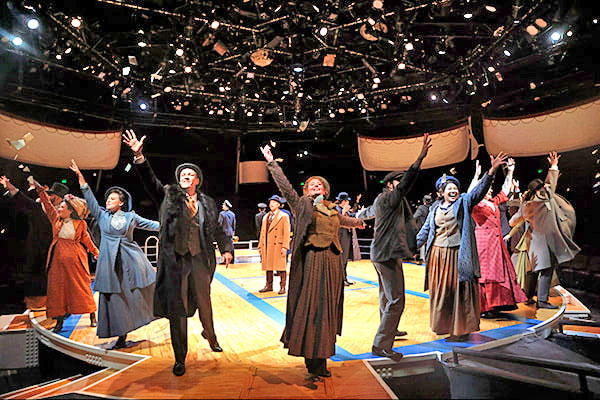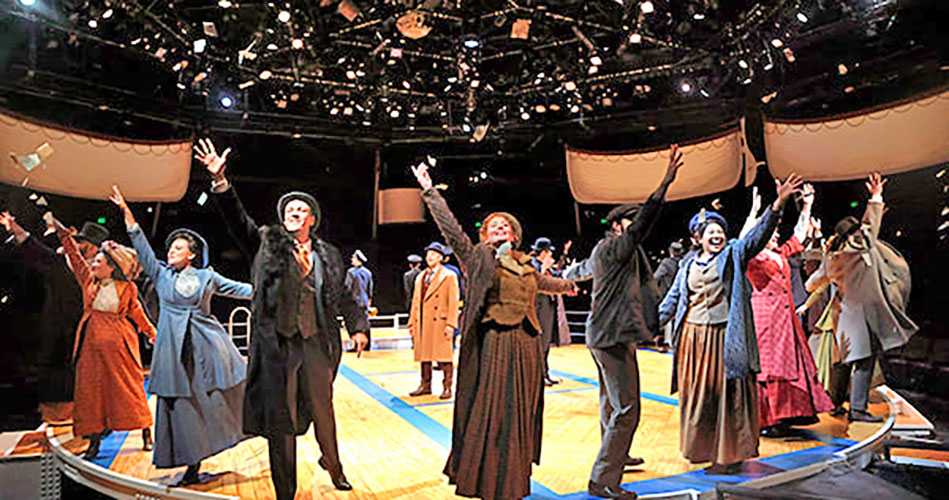
THE CAST of “Titanic—The Musical,” now playing at NSMT through Sunday, November 10. (Paul Lyden Photo)
By GAIL LOWE
BEVERLY — What was it that made North Shore Music Theatre’s most recent production—“Titanic—The Musical”—so successful on official opening night, Wednesday, October 30?
Could it have been Conductor Milton Granger’s ability to pluck from his small orchestra so much sound that it might have been heard all the way down Dunham Road?
Or maybe the strong voices of the entire company that delivered 35 songs throughout the performance — at times smooth and comforting while at other times commanding and powerful but always with a pleasing texture?
Or could it have been the precise and expert direction and choreography on display, compliments of Producing Artistic Music Director Kevin P. Hill?
Perhaps it was the combination of all three components—and more—that held the audience captive for nearly three hours.
Granger, for example, worked with six other musicians to bring out the incredible, high volume songs performed by 19 cast members. There were Granger and Robert L. Rucinski on keyboard, Zoia Bologovsky on violin, Lisa Kempskie on viola; John Bumstead on cello, Caroline Samuels on bass and Michael Ambroszewski on drugs/percussion.
The story of the maiden and ill-fated voyage of the “Titanic,” which sunk on April 15, 1912 in the North Atlantic Ocean after the ship struck an iceberg, is divided into two acts.
During Act One, the audience is introduced to the first, second and third class mostly British passengers who are emotionally intoxicated by the notion that they are about to cross the Atlantic aboard what was then called the “ship of dreams.”
The songs written for Act One include titles like “How Did They Build Titanic?,” “I Must Get on This Ship” and “What a Remarkable Age This Is,” suggesting the awe passengers must have felt when viewing such a large vessel from the dock in Southampton, England prior to sailing.
Act Two showcases their change of heart when it becomes clear that the ship will sink and that there are not enough lifeboats to save everyone’s life. In fact, more than 1,500 people died as a result of the catastrophe with the crew suffering the most casualties.
While Act One is filled with optimism, joy and hope, Act Two is the opposite as passengers come to grips with the dire reality of the situation. Just as the songs written for Act One suggested awe among the passengers, Act Two’s songs bear titles like “To Blame,” “To the Lifeboats” and “We’ll Meet Tomorrow.”
Scenic Designer Jack Mehler kept the stage simple yet effective throughout the production by using marine props, including lifeboats projected above the stage, an anchor and ship’s wheel, that suggest everyone in the theater is aboard the doomed ship.
Director Hill found clever ways to show the difference between the passengers and crew members. As an example, actors Marcus Huber, Brett Hennessey Jones and Dominic Pagliaro were shown working below decks to stoke the fiery furnaces while using shovels as choreography props.
Meanwhile, the Grand Salon quickly changed from a dance hall during Act One where passengers were shown trying out the latest “rag” to a gathering place during Act Two where they would disembark to waiting lifeboats.
Among the famed who died were American business magnate, real estate developer and investor John Jacob Astor IV (Billy Goldstein); co-owner of Macy’s department store Isidor Straus (Kevin B. McGlynn); American businessman Benjamin Guggenheim (Marcus Huber) and designer of the “Titanic” Thomas Andrews Jr. (Trevor Martin).
The ship’s captain and British Naval Officer Edward J. Smith (Tom Galantich) also lost his life. According to historical accounts, his body was never recovered.
Ironically, third class passengers Kate McGowen (Leslie Jackson), Kate Murphey (Marie Eife) and Kate Mullins (Anette Barrios-Torres) were among the survivors.
Worthy of note were the original costume designs, thanks to Jeffrey Meek. Strutting across stage were men wearing bowler hats and waistcoats and women wearing long dresses and hats stylishly trimmed with feathers.
Though the musical boasts 35 songs written by Maury Yeston, it’s unlikely that theater-goers left the theater humming any of the melodies. What they did likely leave with is the story’s sobering message: that all the money in the world will not necessarily save your life.
“Titanic—The Musical” features story and book by Peter Stone with orchestrations by Ian Weinberger.
The final musical of the 2024 season is the 35th anniversary production of “A Christmas Carol” starring David Coffee and Cheryl McMahon.
Performances will begin on Thursday, December 5 and conclude on Sunday, December 22.
CUT
THE CAST of “Titanic—The Musical,” now playing at NSMT through Sunday, November 10. (Paul Lyden Photo)





